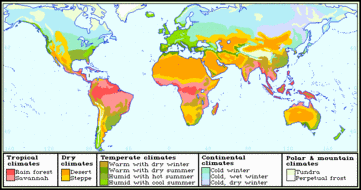The Earth is a sphere and does not have an flat surface. The earth has also has a tilt of about 23.5 degrees. These two factors are responsible for the uneven heating on Earth. The equator receives the most direct sunlight from the sun. The equator receives this sunlight from direct rays, which heats that area more because it is direct. Angled light rays heat areas on the Earth that are further from the equator such as the poles. Moving to about thirty degrees north and south of the equator, the warm air from the equator begins to cool and sink. Between thirty degrees latitude and the equator, most of the cooling sinking air moves back to the equator. I learned this from the the "Global Winds Activity" in class. It helps me to remember this when I think about convection; where as heat at a lower rises, gets cooler, goes back to a lower elevation, and repeats the cycle.
The movement of wind and water on Earth is caused by what is known as the Coriolis effect. The Coriolis effect is when a whereby a mass moving in a rotating system experiences a force acting perpendicular to the direction of motion and to the axis of rotation. What actually happens is that global winds blow diagonally. The Coriolis effect influences wind direction around the world in this way: in the Northern Hemisphere it curves winds to the right; in the Southern Hemisphere it curves them left. The exception is with low pressure systems. Hadley cells are large-scale convection cells that in which air rises at the equator and sinks at lower altitudes.
Doldrums are areas located at the equator and little or no wind activity due to heat rising in the atmosphere. Horse latitudes also are areas with weak winds, but are located at the 30 degree latitude. Trade winds form when air sinks at the 30 degree latitude. Then, the air blows toward the equator, and after that, the wind is deflected by the Coriolis effect. Westerlies form when air sinks at the 30 degree latitude. The winds blow from west to east and is deflected by the Coriolis effect. From the "Global Winds Activity," I learned that horse latitudes and doldrums are very similar, but they are in different locations.
 https://www.google.com/url?sa=i&rct=j&q=&esrc=s&source=images&cd=&cad=rja&docid=WEGGKShygMZ33M&tbnid=DvM2ezsvrJKuNM:&ved=0CAUQjRw&url=http%3A%2F%2Fserc.carleton.edu%2Feslabs%2Fweather%2F3.html
https://www.google.com/url?sa=i&rct=j&q=&esrc=s&source=images&cd=&cad=rja&docid=WEGGKShygMZ33M&tbnid=DvM2ezsvrJKuNM:&ved=0CAUQjRw&url=http%3A%2F%2Fserc.carleton.edu%2Feslabs%2Fweather%2F3.htmlWarm air tends to cause there to be less winds in any given area. For example, Doldrums are areas with no winds because winds because heat rises. With global warming, there will be a lot more heat, which will rise, and eventually cause their to be less wind.